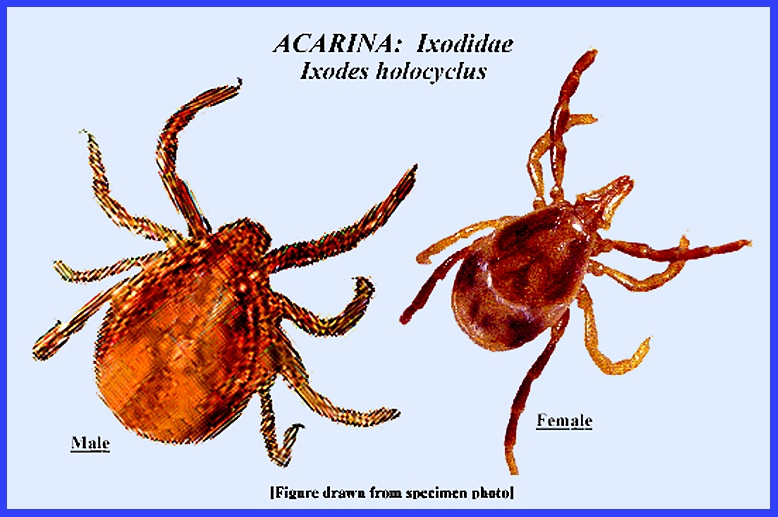File: <australianqfever.htm> <Medical Index> <General Index> Site Description Glossary <Navigate to Home>
|
AUSTRALIAN "Q" FEVER DISEASE (Contact) Please
CLICK on
underlined links for details:
The principal
reservoir host in Australia is the bandicoot rat, Isodon torosus.
The tick Haemaphysalis humeroso
was the main vector. Although this
tick species only bites humans infrequently it is thought that it maintains
the reservoir and that Ixodes holocyclus
(a frequent biter of humans) is a primary vector. Other potential tick vectors are Haemaphysalis bispinosa and Rhipicephalus
sanguineus. The
rickettsiae develop in the epithelium lining of the intestines of the tick so
that the lumen and fecal wastes are highly charged. The feces are highly infectious even when dry, especially to
broken or injured skin. Transmission
is only through fecal wastes of infected ticks entering the wounds or by way
of the respiratory tract. In North
America Coxiella burnetii has
been isolated from the ticks Dermacentor
andersoni, D.
occidentalis and Amblyomma
americanum, and Otobius
megnini. Matheson
(1950) reported that during World War II outbreaks of "Q" fever
occurred among soldiers in Italy and the Balkans. Studies indicated the existence of several closely related
strains of the Rickettsia. Control
involves precautionary behavior, especially avoiding inhalation around
infected animals and carcasses. LIFE CYCLE: Australian "Q" Fever = = = = = = = = = = = =
= = = = = = = = Key References: <medvet.ref.htm> <Hexapoda> Camicas, J. L., J. . Hervy, F. Adam & P. C.
Morel. 1998. The ticks of the world (Acarida,
Ixodida): Nomenclature, Described
Stages, Hosts, Distribution. Paris: Editions de l'ORSTOM. Cox, H. R. 1940.
Rickettsia diaporica
& American "Q" fever.
Amer. J. Trop. Med. 20:
463-469. Davis, Gordon E.
1943. American Q fever;
experimental transmission by the argasid ticks Ornithodoros moubata and O.
hermsi. U. S. Pub. Hlth. Repts 58: 984-987. Derrick, E. H. 1939. "Q" fever entity.
Med. J. Australia 2: 281-299. Derrick, E. H. 1939. Rickettsia burneti: the cause of "Q" fever. Med. J. Australia 2: 14. Derrick, E. H. 1944.
The epidemiology of "Q" fever. J. Hyg. 43: 357-361. Gammons, M. & G.
Salam. 2002. Tick removal. Amer. Fam. Physician 66:
643-45. Gothe, R., K. Kunze
& H. Hoogstraal. 1979. The mechanisms of pathogenicity in the
tick paralyses. J. Med. Ent. 16: 357-69. Hoogstraal, H. 1966.
Ticks in relation to human diseases caused by viruses. Ann. Rev. Ent. 11: 261-308. Hoogstraal, H. 1967.
Ticks in relation to human diseases caused by Rickettsia species. Ann. Rev. Ent. 12: 377-420. Matheson, R. 1950. Medical Entomology. Comstock Publ. Co, Inc. 610 p. Needham, G. R. & P.
D. Teel. 1991. Off-host physiological ecology of ixodid
ticks. Ann. Rev. Ent. 36: 313-52. Parola, P. & D. Raoult. 2001.
Tick-borne typhuses. IN: The Encyclopedia of arthropod-transmitted
Infections of Man and Domesticated Animals. ed. M. W. Service,
Wallingford: CABI: pp. 516-24. Service, M. 2008.
Medical Entomology For Students.
Cambridge Univ. Press. 289 p. Sonenshine, D. E., R. S. Lane & W.
L. Nicholson. 2002. Ticks
(Ixodida). IN: Medical & Veterinary Entomology, ed. G. Mullen & L.
Durden, Ambsterdam Acad. Press. pp 517-58. Sonenshine, D. E. &
T. N. Mather (eds.) 1994. Ecological Dynamics of Tick-Borne
Zoonoses. Oxford Univ. Press, New
York. Steer, A., J. Coburn & L. Glickstein. 2005.
Lyme borreliosis. IN: Tick-Borne Diseases of Humans, ed. J. L.
Goodman, D. T. Dennis & D. E.
Sonenshine. Washington, DC:
ASM Press. |
